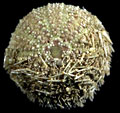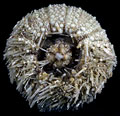|
Diagnostic Features
|
-
Test small, low domal, with ambitus slightly below mid-height.
-
Apical disc small, firmly bound to corona; dicyclic with oculars well separated from periproct. Gential plates with only a few tubercles, not forming a perianal ring. Periproct small, subcircular covered with a large glassy suranal plate; periproct strongly offset.
-
Ambulacra straight, pore-pairs uniserial throughout, no phyllodes. Plating trigeminate with echinid-style compounding. Small primary tubercle to each compound plate. A few much smaller secondary tubercles between primaries and perradially.
-
Interambulacral plates a little wider than tall. Small primary tubercle centrally placed, clearly distinct from the surrounding uniform and rather dense array of small secondary tubercles on all but adoral side.
-
Primary tubercles imperforate and non-crenulate.
-
Small pits around the base of the primary tubercles giving a radial sculpture plus occasional pits amongst the secondary tubercles.
-
Peristome almost half test diameter; buccal notches extremely feeble. Membrane almst naked except for buccal pores.
-
Perignathic girdle with auricles joined perradially.
-
Lantern camarodont.
|
|
Distribution
|
Lower Miocene to Recent, Caribbean, Atlantic, circum Mediterranean, Australia.
|
| Name gender |
feminine |
| Type |
Genocidaris maculata Agassiz, 1869, p. 262, by original designation.
|
| Species Included |
-
Genocidaris maculata Agassiz, 1869; Pleistocene-Recent, Meditteranean, West Indies, Atlantic (East coast N America, Azores, W Atlantic down to the Congo).
-
G. jacquementi (Lambert, 1910); Mid Burdigalian, Miocene, France.
-
G. monilis (Desmarest, in Defrance, 1836); Upper Miocene, France.
-
G. catenata (Desor, in Agassiz & Desor, 1846); Middle Miocene. (Burdigalian-Langhian), France, Egypt.
-
G. fourtaui (Lambert, 1907); Burdigalian, Egypt.
-
G. massylea (Pomel, 1887); Helvetian, Algeria.
-
G. nicaisei (Pomel, 1887); Pliocene, Algeria [probably the same as A. massylea].
-
G. fraasi (Gauthier. 1901); Miocene, Egypt.
-
G. piae (Lovisato, 1895); Langian, Italy.
|
| Classification and/or Status |
Euechinoidea, Camarodonta; Temnopleuroida, Trigonocidaridae.
|
| Remarks |
Distinguished from other trigonocidarids by the dense, uniform secondary tuberculation that covers its ambulacral and interambulacral plates. Small pits are present but usually confined to the suture immediately beneath the primary tubercle.
Borghi et al. (2005) most recently discussed the similarities and differences between Arbacina and Genocidaris but came no firm conclusion.
Agassiz, A. 1869. Preliminary report on the Echini and starfishes dredged in deep water between Cuba and Florida reef by L. F. De Pourtalès, Assist. U.S. coast survey. Bulletin of the Museum of Comparative Zoology, Harvard College, 1 (9), 253-308.
Mortensen, T. 1943. A monograph of the Echinoidea Part III.2, Camarodonta 1. C. A. Reitzel, Copenhagen.
Borghi, E., Campos, I. B. & Garcia, A. R. 2005. Arbacina romana (Merian, 1858) from the lower Pleistocene of Favignana Island (Sicily). Parva Naturalia 7, 47-71.
|



